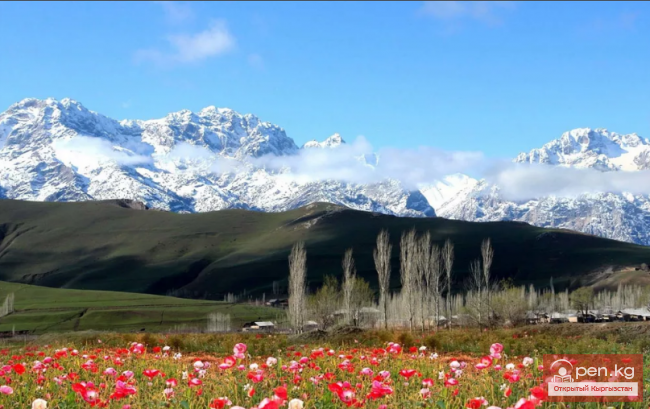Carp Cyprinus carpio
In the dorsal fin III—IV, scales in the lateral line 35—39. In the republics of Central Asia and Kazakhstan, the carp is widespread in the basin of the Aral Sea, the Sary-Su River, Chu, and Issyk-Kul. It has been artificially bred in the Balkhash basin and the Talas River basin. According to F. A. Turdakova, from 1885 to 1890, carp from the Chu River was brought to ponds near Almaty, from where it entered Balkhash through the Ili River in 1913. In 1909, carp was brought by fishermen from Chu to the Talas River basin, and by 1910 it had spread to the lakes of Biilikol, Akkol, Ashykol, and the "Kazoty" lake system (lower reaches of the Talas River). The carp entered Issyk-Kul from Chu around the Quaternary period when the river flowed out of the lake, and it entered Chu from the basin of the Aral Sea when the Chu River was a tributary of the Syr-Darya.
Carp becomes sexually mature in its third year of life. The timing of spawning depends on the spring weather conditions. In the ponds and reservoirs of the Chui Valley and Chu, carp spawning usually begins in the second half of April and continues with interruptions until the end of June. In the lower reaches of the Chu, spawning occurs 10—15 days later than in the water bodies of the Frunze region. In the lakes of the Talas River basin, carp spawning begins from late April to early May and continues until the end of June, with some of the population spawning even in July.
In Issyk-Kul Lake, until recently, carp occupied two of the largest biotopes — the Tyup Bay in the east and the Rybachy Bay in the west. Until the 1940s, these areas had the most powerful carp populations, where 250—300 centners were harvested annually. Besides these areas, carp is found in the Tosor-Tamga region (south) with spawning occurring in the Ak-Chii Bay, in the Jergalan and Pokrovsky bays (north of the lake). It is present in all coastal lakes surrounding Issyk-Kul — Chotkal Lakes, Cholpon-Ata, Karabulun Lakes, and others.
The distribution of this species in the lake is likely directly related to the history of Issyk-Kul. Currently, carp occupies a significantly smaller area than it did in the past, which is a result of changed ecological conditions in its habitats caused by the drop in water levels in the lake. Consequently, over the last few decades, significant areas of shallow waters, well-warmed zones of bays and backwaters previously inhabited by carp have emerged. For example, in the area of the village of Kutura, where 40—45 years ago there was an extensive shallow backwater serving as a mass spawning ground for carp, there is now a meadow. A good carp bay near the steamboat landing of the village of Tyup has completely dried up and turned into a meadow, and the Babiy Log backwater (near the village of Tyup) has significantly shallowed and silted, where, according to locals, there were so many carp that "women caught them with skirts." The backwaters of Nikolaevsky, Chisty, Shiroky, Kurmentinsky, and others have also significantly shallowed.
The drop in water levels in the lake has caused a reduction in the flow of springs along the coast of Issyk-Kul, leading to the salinization of backwaters and bays, especially in the southern part of the lake, in Rybachy Bay and in some backwaters of Tyup Bay.
The biology of the Issyk-Kul carp is as follows. The Tyup population inhabits a relatively deep (15—20 m) and extensive trench located south of the Red Cape (opposite the Dry Ridge area) and stretching southeast almost to the mouth of Jergalan Bay. Here, carp are present almost all year round, except during spawning and fattening periods. With the onset of the spawning period, when the water in the spawning grounds warms to 15—17°C (i.e., usually from mid-May), carp leave the mentioned trench and move in two directions: the main mass of fish goes to Tyup Bay (to the backwaters Rogaty, Ilyin, Nikolaevsky, Shiroky, Chisty, etc.), and a smaller part of the carp heads to Jergalan Bay, to the muddy shallows of the Przhevalsky landing and into the Irdyk Bay.
The Tyup carp population is heterogeneous and consists of two ecotypic forms: the lake form, which, as mentioned above, inhabits the area outside the bay in the extensive trench opposite the Dry Ridge area, and the local backwater form, which inhabits the backwaters of Tyup Bay. For spawning, the lake carp enters the backwaters of the bay, but its spawning occurs later than that of the local backwater form, although it is not excluded that separate schools of carp spawn simultaneously and in the same spawning grounds.
The calendar dates for the spawning run of carp in Tyup Bay, depending on the meteorological conditions of spring, can vary significantly from mid-May to mid-July, and in some cases even until August. Spawning in Tyup Bay occurs in several approaches with intervals between individual approaches of 3 to 10 days, even at the same spawning ground. Experienced fishermen assert that the Tyup carp has three spawning runs. The first begins around May 23—24 and lasts about one week, then the run stops and only resumes after a week, but lasts briefly — 3—4 days; finally, the third run begins in mid-June and lasts until the first days of July.
“Fish of Kyrgyzstan,” I.A. Pivne
Fish















































